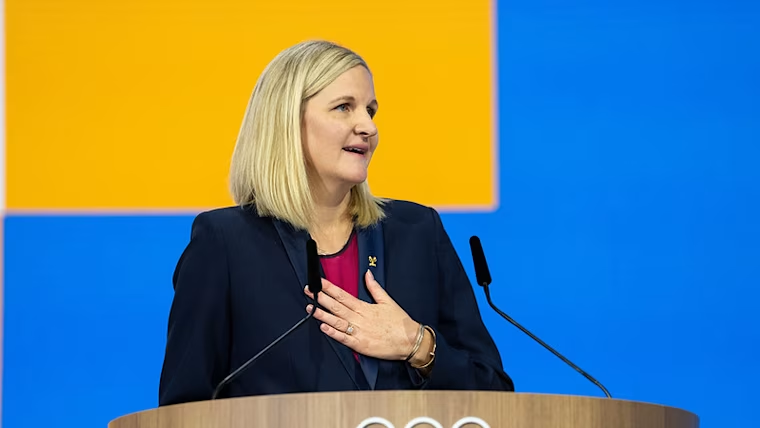Uttar Pradesh Switch to Hindi
IOC Gets First Woman President
Why in News?
On 23rd June 2025, Kirsty Coventry became the first female and first African president of the International Olympic Committee (IOC), coinciding with the IOC's 131st anniversary.
- Thomas Bach, the outgoing president who completed his 12-year term starting in 2013, now assumes the honorary title of IOC President.
Key Points
About Kirsty Coventry
- Olympic Success: She is Zimbabwe’s most successful Olympian, having won seven of the country’s eight Olympic medals to date.
- No African athlete has won more Olympic medals than Coventry, who specialized in backstroke and medley swimming.
- Olympic Medals: At the Athens 2004 Olympics, she won three medals: a gold in the 200m backstroke, a silver in the 100m backstroke, and a bronze in the 200m medley.
- She defended her 200m backstroke title at Beijing 2008 and added three silver medals.
- World Titles and Retirement: Coventry won three long-course world titles in 2005 and 2009, along with four short-course gold medals in 2008.
- She retired from competitive swimming after the Rio 2016 Olympics, marking her fifth Olympic appearance.
- Government Role: In September 2018, she was appointed as Zimbabwe's Minister of Youth, Sport, Arts, and Recreation.
- IOC Involvement: Elected to the IOC in 2013 as a member of the Athletes’ Commission, she was re-elected as an individual IOC member in 2021.
- Role as IOC President:
- She will oversee the Olympic Winter Games Milano Cortina 2026 as her first Olympic Games.
- She will also be overseeing the selection of the 2028 Summer Games host city.
- Potential bids from Qatar and Saudi Arabia are under consideration, with the IOC's new process allowing fast-tracking of a preferred candidate.
- She will hold a closed-door session with around 100 IOC members, including current and former heads of state, business leaders, athletes, and Olympic sports leaders.
- She emphasized her role as a "guardian" of the Olympic platform, dedicated to inspiring, changing lives, and bringing hope worldwide, while leading the International Olympic Committee for the next eight years.
International Olympic Committee (IOC)
- The IOC is a non-governmental international organisation based in Lausanne, Switzerland, that came into existence in 1894.
- The IOC decides the rules and regulations of the Olympic Games and when and where the next Olympic event will be held.
- The IOC is a permanent organisation that elects its own members, with each member speaking French or English and being a citizen of or residing in a country with a National Olympic Committee.
- The IOC is the final authority on all questions concerning the Olympic Games and the Olympic movement.
- The IOC aims to ensure the regular holding of the Olympic Games and foster Olympism and the Olympic movement.
- Olympism is a philosophy that blends sport, culture, education, and international cooperation, emphasizing the joy of effort, the educational value of good examples, social responsibility, and respect for universal ethical principles.
- The goal of the Olympic Movement is to contribute to building a peaceful and better world by educating youth through sports practised in accordance with Olympism and its values.
- The three main constituents of the Olympic Movement are the IOC, the International Sports Federations (“IFs”), and the National Olympic Committees (“NOCs”).


Uttar Pradesh Switch to Hindi
Jahnavi Dangeti
Why in News?
Jahnavi Dangeti, a 23-year-old from Palakollu, West Godavari district, Andhra Pradesh, has been selected as an Astronaut Candidate (ASCAN) for the 2029 space mission of Titan Space Industries (TSI), a U.S.-based private space research agency.
An Astronaut Candidate (ASCAN) is an individual who has been selected by a space agency or organization for astronaut training, with the goal of qualifying them for spaceflight missions.
Key Points
About Jahnavi Dangeti
- She completed her schooling in Godavari district, then pursued a Bachelor's in Electronics and Communication Engineering at Lovely Professional University (LPU) in Punjab, while her parents, Padmasri and Srinivas, reside in Kuwait.
- She became the youngest foreign Analog Astronaut and the first Indian at the Analog Astronaut Training Centre (AATC) in Kraków, Poland, in 2022.
- She has worked with the International Astronomical Search Collaboration (IASC), sponsored by NASA, and contributed to asteroid discovery using the Pan-STARRS telescope in Hawaii.
- Jahnavi has received multiple awards, including the People’s Choice Award at the NASA Space Apps Challenge and the Young Achiever Award at ISRO's World Space Week celebrations.
- Union Minister of Civil Aviation congratulated her for becoming the first Indian to complete NASA’s International Air & Space Programme, marking her achievement as a proud moment for India.
About Titans Space Mission
- The mission, set for 2029, will be led by Colonel (Retd.) William McArthur Jr., a veteran NASA astronaut.
- The US-based mission will take around five hours, during which time the crew will fly around the planet twice, experiencing two sunrises and two sunsets.
- The mission will yield close to three hours of continuous zero gravity, providing a revolutionary environment for scientific investigation and human spaceflight development.
- Jahnavi will begin astronaut training in 2026, which will include flight simulations, spacecraft procedures, survival training, and medical and psychological evaluations.
Other Key Indian Space Milestones:
- Axiom-4 (Ax-4) Mission (2025): Group Captain Shubhanshu Shukla became the second Indian to travel to space and will be the first to visit NASA's International Space Station (ISS).
- The four-member crew(Peggy Whitson of the US, Slawosz Uznanski-Wisniewski from Poland, and Tibor Kapu from Hungary) will carry out 60 scientific experiments, including seven contributed by India.
- ISRO's experiments aim to enhance our understanding of space, its biological effects, and microgravity, with one key experiment examining the impact of spaceflight on six types of crop seeds.
- Russian Soyuz Mission (1984): Rakesh Sharma became the first Indian to fly to space, marking a historic milestone for India’s space journey.


Uttar Pradesh Switch to Hindi
CIP-South Asia Regional Centre (CSARC), Agra
Why in News?
The government has approved the establishment of the South Asia regional center of the Peru-based International Potato Center (CIP) in Singna, Agra district, Uttar Pradesh.
- The CIP regional centre in India will cater to both domestic farmers and those in other South Asian countries.
Key Points
- Objective: The primary objective of the project is to enhance food and nutrition security, increase farmers' income, and generate employment by improving potato and sweet potato productivity, post-harvest management, and value addition.
- Project Cost: The Uttar Pradesh government has allocated 10 hectares of land for the proposed centre.
- The total cost of the project is ₹171 crore, with India contributing ₹111 crore and the CIP (International Potato Center) providing ₹60 crore.
- Impact on Employment: India’s potato sector holds significant potential for job creation in areas such as production, processing, packaging, transportation, marketing, and the broader value chain.
- Innovation: The CSARC (Central Potato and Sweet Potato Research Centre) will develop high-yielding, nutrient-rich, and climate-resilient varieties of potatoes and sweet potatoes, which will accelerate sustainable development not only in India but also across South Asia through world-class scientific research and innovation.
- India’s Potato Production: India is the second-largest producer and consumer of potatoes globally, with a production of 51.30 million tonnes in 2020.
- Together, India and China account for more than one-third of the global potato production, which totaled 359.07 million tonnes in 2020.
- Key Producing States in India: Uttar Pradesh and West Bengal lead potato production, each contributing 15 million tonnes in 2020-21.
- Bihar produces 9 million tonnes, with Gujarat, Madhya Pradesh, and Punjab also being significant contributors.
Related Institutions
- International Potato Center (CIP): It was founded in 1971, is headquartered in Lima, Peru, and focuses on potato, sweet potato, and Andean roots and tubers.
- China established the China Center for Asia Pacific (CCCAP) in Yanqing, Beijing, in 2017 to serve the East Asia and Pacific region.
- Indian Council of Agricultural Research (ICAR): The Indian Council of Agricultural Research (ICAR) operates two institutions focusing on tuber crops: ICAR-CPRI (Central Potato Research Institute) in Shimla, which works on potatoes, and ICAR-CTCRI (Central Tuber Crops Research Institute) in Thiruvananthapuram, which focuses on sweet potatoes.
- Other Agricultural Centre Establishment: In 2017, the Ministry of Agriculture supported the establishment of a regional centre for the Philippines-based International Rice Research Institute (IRRI) in Varanasi, India.




.png)








.png)


.jpg)



 PCS Parikshan
PCS Parikshan




